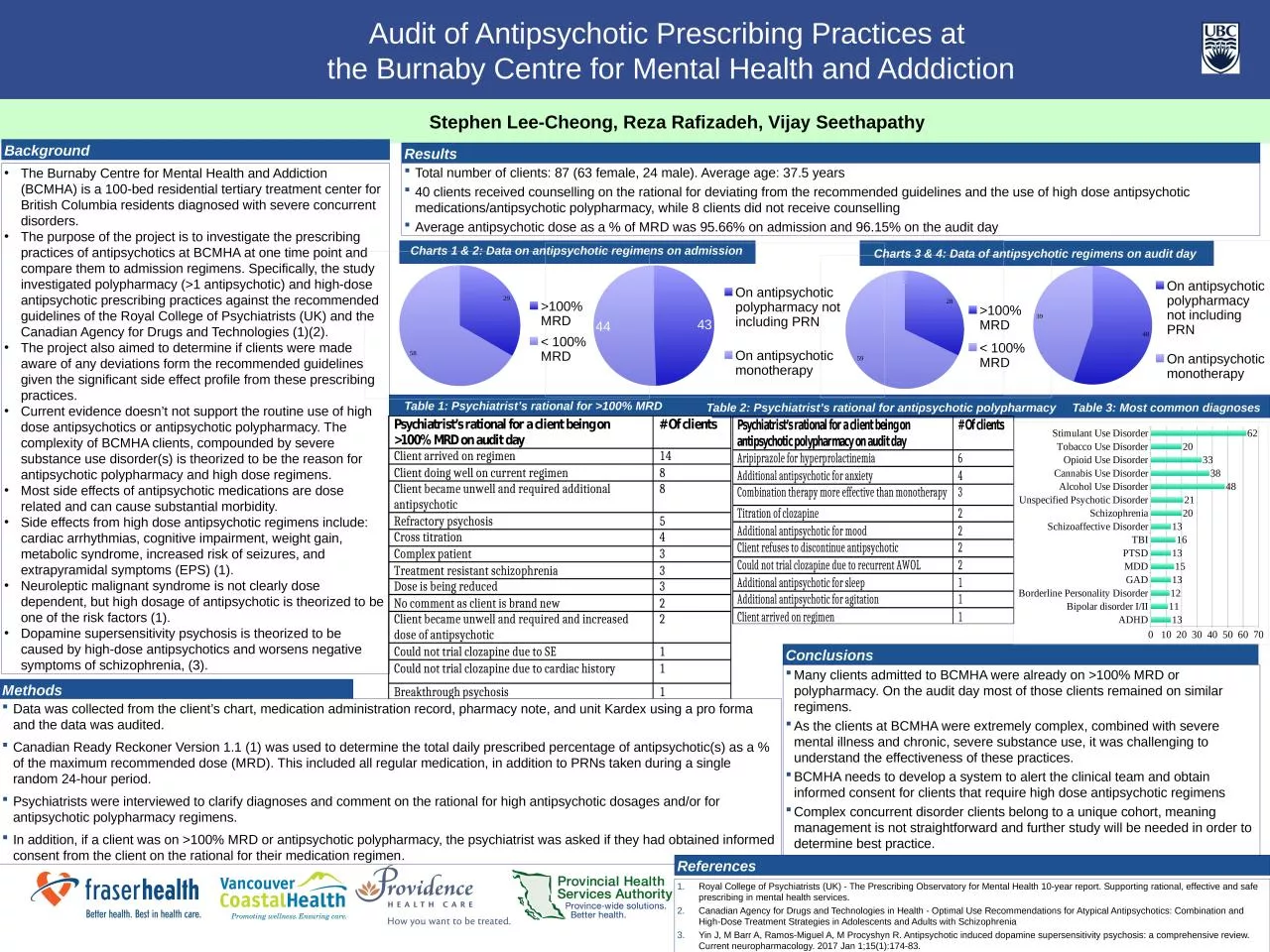

residential tertiary treatment center for British Columbia residents diagnosed with severe concurrent disorders The purpose of the project is to investigate the prescribing practices of antipsychotics at BCMHA ID: 932758
Download Presentation The PPT/PDF document "Background The Burnaby Centre for Mental..." is the property of its rightful owner. Permission is granted to download and print the materials on this web site for personal, non-commercial use only, and to display it on your personal computer provided you do not modify the materials and that you retain all copyright notices contained in the materials. By downloading content from our website, you accept the terms of this agreement.
Slide1
Background
The Burnaby Centre for Mental Health and Addiction (BCMHA) is a 100-bed
residential tertiary treatment center for British Columbia residents diagnosed with severe concurrent disorders.The purpose of the project is to investigate the prescribing practices of antipsychotics at BCMHA at one time point and compare them to admission regimens. Specifically, the study investigated polypharmacy (>1 antipsychotic) and high-dose antipsychotic prescribing practices against the recommended guidelines of the Royal College of Psychiatrists (UK) and the Canadian Agency for Drugs and Technologies (1)(2). The project also aimed to determine if clients were made aware of any deviations form the recommended guidelines given the significant side effect profile from these prescribing practices.Current evidence doesn’t not support the routine use of high dose antipsychotics or antipsychotic polypharmacy. The complexity of BCMHA clients, compounded by severe substance use disorder(s) is theorized to be the reason for antipsychotic polypharmacy and high dose regimens.Most side effects of antipsychotic medications are dose related and can cause substantial morbidity. Side effects from high dose antipsychotic regimens include: cardiac arrhythmias, cognitive impairment, weight gain, metabolic syndrome, increased risk of seizures, and extrapyramidal symptoms (EPS) (1). Neuroleptic malignant syndrome is not clearly dose dependent, but high dosage of antipsychotic is theorized to be one of the risk factors (1).Dopamine supersensitivity psychosis is theorized to be caused by high-dose antipsychotics and worsens negative symptoms of schizophrenia, (3).
Methods
Data was collected from the client’s chart, medication
administration record, pharmacy note, and unit Kardex using a pro forma and the data was audited.Canadian Ready Reckoner Version 1.1 (1) was used to determine the total daily prescribed percentage of antipsychotic(s) as a % of the maximum recommended dose (MRD). This included all regular medication, in addition to PRNs taken during a single random 24-hour period. Psychiatrists were interviewed to clarify diagnoses and comment on the rational for high antipsychotic dosages and/or for antipsychotic polypharmacy regimens. In addition, if a client was on >100% MRD or antipsychotic polypharmacy, the psychiatrist was asked if they had obtained informed consent from the client on the rational for their medication regimen.
Total number of clients: 87 (63 female, 24 male). Average age: 37.5 years
40 clients received counselling on the rational for deviating from the recommended guidelines and the use of high dose antipsychotic medications/antipsychotic polypharmacy, while 8 clients did not receive counsellingAverage antipsychotic dose as a % of MRD was 95.66% on admission and 96.15% on the audit day
Results
Conclusions
Many
clients admitted to BCMHA were already on >100% MRD or polypharmacy. On the audit day most of those clients remained on similar regimens. As the clients at BCMHA were extremely complex, combined with severe mental illness and chronic, severe substance use, it was challenging to understand the effectiveness of these practices.BCMHA needs to develop a system to alert the clinical team and obtain informed consent for clients that require high dose antipsychotic regimensComplex concurrent disorder clients belong to a unique cohort, meaning management is not straightforward and further study will be needed in order to determine best practice.
Table
1: Psychiatrist’s rational for >100% MRD
Table
2: Psychiatrist’s rational for antipsychotic polypharmacy Table 3: Most common diagnoses
Stephen Lee-Cheong, Reza Rafizadeh, Vijay Seethapathy
Audit of Antipsychotic Prescribing Practices at the Burnaby Centre for Mental Health and Adddiction
Charts 1 & 2: Data on antipsychotic regimens on admission
Charts 3 & 4: Data of antipsychotic regimens on audit day
References
Royal
College of Psychiatrists (UK) - The Prescribing Observatory for Mental Health 10-year report. Supporting rational, effective and safe prescribing in mental health services
.
Canadian Agency for Drugs and Technologies in Health - Optimal Use Recommendations for Atypical Antipsychotics: Combination and High-Dose Treatment Strategies in Adolescents and Adults with
Schizophrenia
Yin J, M Barr A, Ramos-Miguel A, M Procyshyn R. Antipsychotic induced dopamine supersensitivity psychosis: a comprehensive review. Current neuropharmacology. 2017 Jan 1;15(1):174-83.